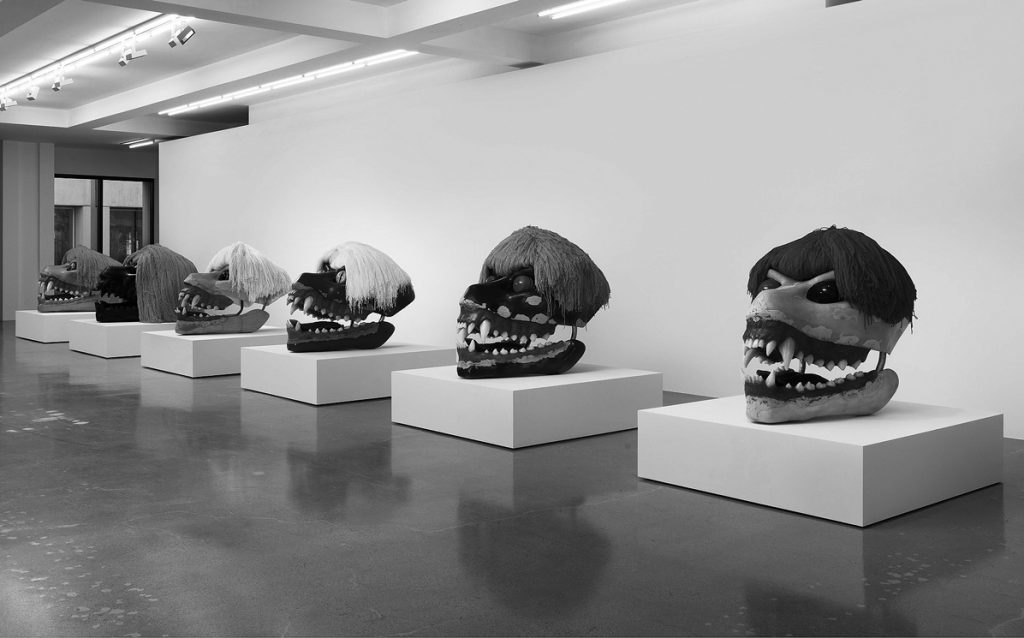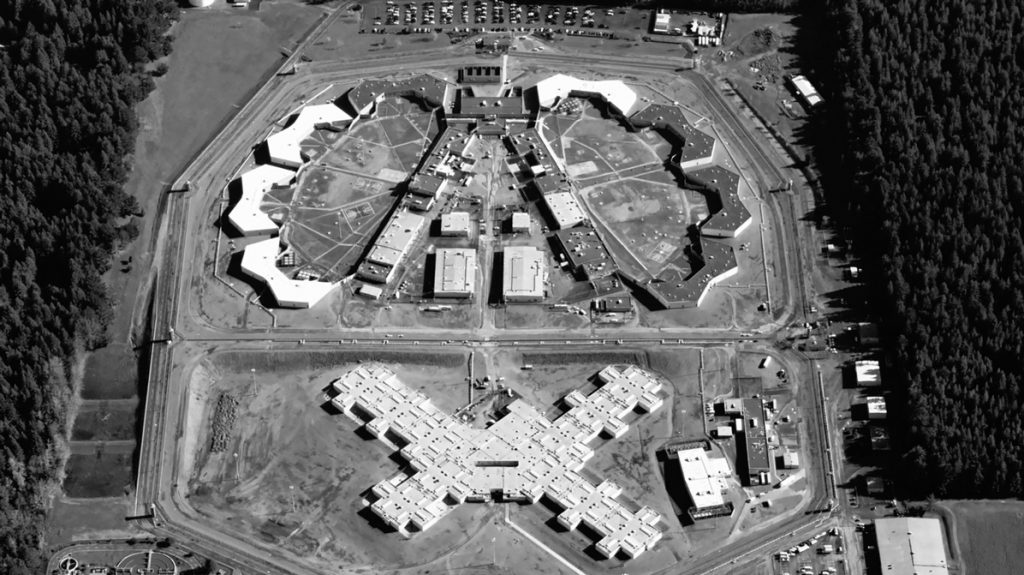Navigating the Ruby Con:
Force Majeure and Sterling
Ruby’s Damnation
Sterling Ruby: Damnation
Sprüth Magers, Los Angeles
13.02.19 – 23.03.19
Earthquakes occupy a special place in the grim mythology of the American West, as do the wildfires, tsunamis, high-speed winds, landslides and floods that plague California. Emergency preparedness and resiliency training is recommended standard practice in the region. Grassroots initiatives such as America’s PrepareAthon!, which devised a playbook for running a role-playing game-like earthquake simulation exercise, remind the public that ‘Everyone has a role to play to prepare for a disaster. All employers and organisations – from local businesses and municipalities to schools, universities, and faith- and community-based organisations – are essential components of the community and can help people and groups to be more prepared.’1 In recognition of their unique security obligations, I would add prisons and museums to the list, especially if the latter were located on or near a geological anomaly, such as the cultural institutions that comprise Los Angeles’s Museum Row.

Sterling Ruby: Damnation. Installation view, Sprüth Magers, Los Angeles, 13 February – 23 March 2019. © Sterling Ruby. Courtesy the artist and Sprüth Magers. Photo: Robert Wedemeyer.“斯特林·鲁比:诅咒”展览现场,斯布鲁斯·马格斯画廊,洛杉矶,2019年2月13日至3月23日。© Sterling Ruby.图片致谢艺术家与斯布鲁斯·马格斯画廊, 摄影:Robert Wedemeyer。
The Los Angeles County Museum of Art ( LACMA ), for example, lies approximately 1 kilometre east of the nearest liquefaction zone ( as per the California Governor’s Office of Emergency Services ‘My Hazards’ database ) and, according to a City of Los Angeles Department of City Planning Parcel Profile Report, 3.0562296 kilometres from the nearest fault zone. It is also erected on the grounds above a subterranean oil field, as evidenced by the adjacent La Brea Tar Pits, placing it squarely within a methane hazard zone.
Due to fossil fuel deposits, subsurface methane concentrations are so rich in parts of Southern California that one can stick a pipe in the ground and light it for torch. Buildings without proper ventilation and monitoring equipment risk methane accumulation in rooms that ultimately blow up. To wit: on 24 March 1985 a pocket of methane exploded in a Ross Dress for Less clothing store north of LACMA. A Los Angeles Times article, published the next day, described the injured, the missing, the damaged, and the ‘fiery cracks’ in the earth that ‘spouted columns of flame’. At the time of writing, the cause of the explosion was undetermined; all anyone knew was gas, the likely culprit, ‘continued to seep to the surface – and burst into flame – in a steady progression across the parking lot’.2 Methane: deep time, unleashing modern doom.
And doom is hot right now in the popular ethos, what with the planet dying. Living in the eschaton feels sexy and exciting, like everything does and does not matter; everything is permissible, as long as the fantasy holds up that the last day will never come. This is why the conversation around ecological collapse, especially in contemporary art, is so frequently aestheticised through speculative fictions – the bones of the matter are too evocative of the fossils we will become, to heed them plainly.
A rather literal case in point is Sterling Ruby’s solo exhibition, Damnation. On display from 13 February to 23 March 2019 at Sprüth Magers, a blue-chip gallery across the street from LACMA and 3.01151544 kilometres from the nearest fault lines, it included a 2018 sculpture series entitled Skulls. The press release explained that ‘these oversized, animal-like skulls are in fact facsimiles of the underlying armatures of Hollywood special effects creatures’. Like most exposed armatures, the works are grotesque for their sheer nakedness. That they look like prehistoric remains decorated by a fourth-grader with a caffeine addiction and something to prove, only betrayed the reality that they have nothing to prove beyond a ‘fuck it, be cool’ attitude. Whatever meditations on death, waste and mass extinction Skulls might have inspired – that they might have been the allegorical faces of methane or memento mori for an entertainment industry complicit with excesses of twenty-first-century America – were lost among the arbitrary party-monster gear.
What Skulls lacked in critical integrity was made up for, albeit not without kinks, by State ( 2019 ), the only other work that was on view in Damnation. Incarceration is the theme of State, a single-channel video projection running slightly over half an hour in duration. Its subjects are the thirty-five adult state prisons of the California Department of Corrections and Rehabilitation ( CDCR ), filmed via a helicopter in the airspace above. From these aerial views, the prisons abstract into geometric shingles often indistinguishable from one another. Interspersed are moments of further abstraction, in which Californian topography rolls by as pure, barren texture, and the sound of drums is superimposed over all. The relentless, driving beat is likely what prompted some critics to find the work menacing in tone and therefore detect an illusion of skulls within the patterns on screen – although perhaps their apophenia was provoked by the sculptures already described.
Ruby’s vision of the carceral state is contingent upon the cold, distant gaze he uses to examine the prisons, and to highlight their severity, geographic isolation and quantity. This is the work’s greatest asset and greatest flaw. It is no secret the United States has the largest prison population in the world, a fact that raises serious concerns about the functional nature of its judiciary and law-enforcement agencies. Given the historic disparity between the percentage of incarcerated people of colour as compared to the number of incarcerated white people, these concerns are interlocked with crucial issues of systemic prejudice.
From the lofty perspectives offered in State, the very real, very human element of the penal system becomes wholly diminished. Following the 2019 Ridgecrest earthquakes – the strongest of which registered a 7.1 magnitude on the Richter scale – this particular shortcoming acquired new demerits, as the human element seemed further engulfed by Ruby’s monumental, alienating terrain, which had more in common with the riven Ross Dress for Less parking lot than it did with anything one might call a populated landscape.
So, what happens to incarcerated people, should force majeure come their way? Terry Thornton, Deputy Press Secretary of the CDCR Office of Public and Employee Communications, graciously fielded my question. For security reasons, she was unable to provide detailed information about emergency protocol at any given prison, least of all the California City Correctional Facility and California State Prison-Los Angeles, the two facilities closest to Ridgecrest, but she assured me the CDCR was resilient and prepared for large-scale emergencies. ‘There was no damage at those prisons because of those earthquakes, so what does that tell you?’ she asked, before confirming that employees were trained for every hazard and disaster plan and that the prisons themselves were structurally retrofitted or built to withstand a major temblor. I gathered her comments were also necessarily general, because disasters yielded unpredictable scenarios, despite expert efforts to model their outcomes. The dangers that an earthquake, a wildfire or ( for a place like San Quentin State Prison ) a tsunami might unleash are but an educated guess.
The most striking aspect of my conversation with spokes-woman Thornton was the empathy she expressed for the CDCR community, which includes employees and inmates alike. When she told me that the department was committed to preserving life, it was with a sincerity that transcended the rote standards of a media liaison officer simply doing her job.
Yet compassionate intentions do not change the fact that, as of 31 December 2016, the number of incarcerated people in California exceeded 200,000 and the number of incarcerated people in the United States was almost 2.2 million.3 Just like the good optics of donating the exhibition proceeds from State to the American Civil Liberty Union ( ACLU ) of Southern California does not change the fact that the video – valued at several hundred thousand dollars, and released in an edition of three with an artist’s proof – was made by a man with the means to actualise a personal creative vision that literally looks down on the incarcerated.
Ms. Thornton’s phrase, ‘preserving life’, turns in several registers. For her, it embodies a mission to protect communities on both sides of a security gate. It also implies containment, a confined existence in a holding pattern, i.e. a person in a cell. At its most complete, it connotes stasis, an animal suspended in pitch, evidence of an existence over and done. Had Ruby encouraged the preservation of life in his recent projects, his artistic efforts would have been a heartening contribution to urgently important debates about ecology and injustice that inform the American psyche. Sadly, he did not, so visitors like me had to take their musings elsewhere.
A stone’s throw from Sprüth Magers are the La Brea Tar Pits, most of which open to the sky. The Observation Pit, however, is housed in a small, round building. On the inside, its spiral staircase, circular skylights and observation deck resemble a panopticon. One can wind to the bottom for a closer look at the fossilised remains of animals trapped by tar, as well as bits of trash scattered by disrespectful guests. Some of the bones are situated as they were found; others, I was told, were planted for effect. Damnation, it seems, is but a construct..
1. Federal Emergency Management Agency, Prepare Your Organization for an Earthquake – Playbook, p. 1 <https://www.fema.gov/media-library-data/1409865580490-e83e2d1b906d35cc766477cb9459ca0e/prepareathon_playbook_earthquakes_final_090414_508a.pdf>.
2. George Ramos and Steve Harvey, ‘Gas Explosion Shatters Fairfax Store; 23 Hurt’, Los Angeles Times, 25 March 1985 <https://www.latimes.com/archives/la-xpm-1985-03-25-mn-21303-story.html>.
3. Danielle Kaeble and Mary Cowhig, Correctional Populations in the United States, 2016 ( Washington, DC: Bureau of Justice Statistics of the U.S. Department of Justice ), April 2018, p. 2 <https://www.bjs.gov/content/pub/pdf/cpus16.pdf>.
“航行于鲁比孔河”:不可抗力与斯特林鲁比的“诅咒”
斯特林客鲁比:诅咒
斯布鲁斯客马格斯画廊,洛杉矶
2019年2月13日-2019年3月23日
译 / 梁霄
就像肆虐加州的野火、海啸、飓风、山体滑坡和洪水一样,地震在美国西部的严酷神话中占有特殊的地位。应急准备和心理恢复训练在这个地区向来被视为标准操作。诸如“America’s PrepareAthon!”译注1这样的国家性基层动员行动就为角色扮演型的模拟地震练习设置了脚本,并提醒公众:“每个人都有责任为灾害做准备。所有的雇员和组织——从地方企业和市政当局到中小学,大学,宗教和社团组织——都是社区的重要组成部分,能够帮助人群做好更充分的准备。”1考虑到监狱和博物馆特殊的安全保障义务,我想我会把它们列入上述名单,尤其是在后者靠近或恰恰坐落于地质异常地带的情况下,例如那些洛杉矶博物馆街上的文化机构。
洛杉矶州立艺术博物馆就位于距它最近的地震液化带以东一公里处(据加州州长紧急服务办公室“危险警告”数据库显示);而按照洛杉矶市规划部门地块概况报告的说法,这座博物馆距离最近的断层带也只有3.0562296公里。与此同时,它还坐落在一块地下油田的上面,正好处于甲烷危险区,毗邻的拉布雷亚沥青坑博物馆就是证据。
由于化石燃料沉积,南加州部分地区的地下甲烷浓度格外高,人们可以往地面插入一根管道,点燃后把它当作火炬。没有装配适当通风和检测设备的建筑物很有可能因室内甲烷堆积引发爆炸。例如1985年3月24日,在洛杉矶州立艺术博物馆北边的一家“罗斯廉价服饰”用品店便发生了甲烷爆炸。隔天的《洛杉矶时报》发表了一篇文章,描述了受伤的人、失踪的人和生活受损的人,并且提到了“从地面的缝隙中”喷射出的“条条火柱”。在文章发表之时,爆炸的原因还尚未确定;但所有人都知道,罪魁祸首很可能是天然气,“它们继续向地表渗透——旋即突然燃烧——在停车场里蔓延成一片”。2甲烷:从时间深处释放的现代厄运。
而“厄运”在当下的风潮中则十分流行,因为我们的星球正在死亡。生于末世令人感到兴奋和激动,所有的事情都无所谓;只要幻想最后一日永不降临,一切就都是被允许的。这就是为何关于生态崩溃的讨论,尤其是在当代艺术的范畴内,经常会被投机性的虚构美化——事情的轮廓总让我们深刻地回忆起化石,那些我们将清楚地注意到的东西。
斯特林客鲁比(Sterling Ruby)的个人展览“诅咒”(Damnation)便是一个相当贴切的例子。展览于2019年2月13日至3月23日在斯布鲁斯客马格斯画廊举办,这家蓝筹画廊就开在洛杉矶州立艺术博物馆的对面,距离最近的断层带3.01151544公里。“诅咒”囊括了艺术家在2018年创作的系列作品“头骨”(SKULLS)。展览的媒体资料解释道:“这些巨型动物头骨实际上是好莱坞特效生物骨架部件的复制品。”就像大多数曝露在外的骨骼组织一样,这些“头骨”因为纯粹的赤裸而显得格外怪诞。它们看起来就像是经过一名四年级学生手工装饰过的史前化石,而这名学生则似乎在纱线工艺上别有天赋,对咖啡上瘾,甚至想要证明些什么东西。但他好像只是背叛了一个简单的事实:除了“去他妈的,冷静点”的态度之外,他没有什么可证明的。无论“头骨”系列能够激发出关于死亡、浪费和大规模灭绝的何种思考——可能是甲烷的寓言性面孔,或者是与21世纪膨胀发展的美国进行合谋的娱乐行业的死亡象征——它们都伴随着肆意的派对怪物装扮而消失了。
“头骨”系列在批判完整性方面的不足,因为展览中的另一件作品《国家》(STATE)而得以弥补,即便这种弥补有些勉强。这部以监禁为主题的单屏影像,时长略超过半个小时。片中,斯特林客鲁比通过直升机在空中拍摄了加州惩教和康复部(CDCR)下设的三十五所州立成人监狱。从艺术家获得的这些鸟瞰图来看,监狱被抽象成了几何状的屋面板瓦,彼此往往难以区分。而监狱与监狱之间则穿插着更为抽象的瞬间,加利福尼亚州的地貌特征以纯粹、贫瘠而荒芜的纹理在屏幕里滚动而过,鼓声盘旋其上。无情的、强烈的鼓点或许是一些评论家认为作品在基调上具有威胁性的原因,所以他们在影像中那些抽象的图案里发现了头骨的形状——尽管他们的幻想性错觉很可能是由展览中已经出现的那些雕塑引起的。
鲁比对“监狱国家”(carceral state)的看法,取决于他用来审视监狱的那种冷漠而遥远的目光。通过这种目光,他强调了监狱的严重性、它们的地理隔绝程度和它们的数量。这是作品最大的优点和最大的缺陷。美国拥有世界上最多的监狱人口,这个已经不再是秘密的事实引发了关于美国司法和执法机构职能性质的严重担忧,考虑到被监禁的有色人种数量与被监禁的白人数量之间的历史差异,这些担忧与系统性的种族主义、阶层歧视以及非法拘禁等关键议题互相联系。
从影像所提供的崇高视角出发,我们会发现刑罚制度中那些非常真实、非常人性化的部分完全消失了。在2019年里奇克莱斯特大地震之后——其中最强烈的一次为里氏7.1级——影像里这一特别的缺陷在我的脑海中又增添了新的过失,人的元素似乎被艺术家那宏伟而陌生的地形进一步吞没了,它所呈现的东西就像“罗斯廉价服饰”用品店被烈火劈开的停车场,而与任何可以称为人口稠密的景观无关。
那么,如果不可抗力发生,被囚禁在监狱里的人会怎么样呢?
加州惩教和康复部公众与员工交流办公室的副新闻秘书特里客桑顿(Terry Thornton)礼貌地回答了我的问题。由于安全原因,她无法提供任何一所特定监狱应急预案的详细信息,尤其是距离里奇克莱斯特最近的两所监狱——加州城市教养所和洛杉矶加州州立监狱。但她向我保证惩教和康复部的处理方式是有弹性的,他们会为大规模的紧急情况做好准备。“那些监狱并没有因为地震而受损,这说明了什么?”特里客桑顿问道。她确认监狱里的雇员都接受过应对各种灾害的培训,而监狱本身也在建筑结构上进行过改造,以便抵御地震带来的危险。但我想她的回答很可能是泛泛而谈,因为即便专家们努力模拟了灾害的种种后果,实际上还是会发生不可预测的情况。地震、野火或者海啸(对于圣昆丁州立监狱这样的地方来说)能够引发的危险,不过只是一种有根据的猜测。
与发言人特里客桑顿的交谈中,最令我印象深刻的是她对监狱社区的感同身受,包括对其中的雇员和囚犯。当她告诉我惩教和康复部致力于保护生命时,她流露出的真诚超越了媒体联络员在履行本职工作时的那种机械标准。
然而,电话中的温暖、坦率和融洽并不能改变这样一个事实:截至2016年12月31日,加州被监禁人数超过20万,3而美国总体被监禁人数则接近220万。正如将从作品《国家》中获得的展览收益捐赠给位于美国南加州的美国民权联盟的善意也不能改变这样一个事实:这部拥有三个版本、携带证明文件并且价值25万美元的影像作品,由这样一位艺术家创作。他的艺术方法实现了一种个人化的创造性视野,但正是这种视野从高处蔑视着那些影像中的被监禁者。

Sterling Ruby, State, 2019, still from single-channel video, TRT 00:33:11, edition of 3 + AP. © Sterling Ruby. Courtesy the artist and Sprüth Magers. 斯特林·鲁比,《国家》,2019,单屏影像静帧截屏,TRT 00:33:11, edition of 3 + AP. © Sterling Ruby.图片致谢艺术家与斯布鲁斯·马格斯画廊。

Sterling Ruby, State, 2019, still from single-channel video, TRT 00:33:11, edition of 3 + AP. © Sterling Ruby. Courtesy the artist and Sprüth Magers. 斯特林·鲁比,《国家》,2019,单屏影像静帧截屏,TRT 00:33:11, edition of 3 + AP. © Sterling Ruby.图片致谢艺术家与斯布鲁斯·马格斯画廊。
特里客桑顿女士所说的“保护生命”展现了多种不同层面的含义。对她而言,“保护生命”意味着保护安全门两侧不同群体的使命;与此同时,它也意味着“封闭”,一种在特定模式中被禁锢的存在,比如一个被锁在牢房里的人。如果想让这句话更加完整,它则更意味着“停滞”,一只在颠簸中悬浮的动物,一种存在经历和留下的证据。如果斯特林客鲁比在他最近的创作中能够体现出这一点,那么他的艺术实践将会变成足以鼓舞人心的贡献,参与到关于生态、不平等和不公正等等重要的辩论中去,正是这些议题影响着美国人的灵魂。遗憾的是,斯特林客鲁比没有这样做,因此像我这样的观众则不得不考虑到别处去思考。
拉布雷亚沥青坑博物馆(La Brea Tar Pits)距离斯布鲁斯客马格斯画廊仅有一箭之遥,场馆中的大部分空间是露天的。然而,观测坑却位于一座小型圆形建筑里,其内部的旋转楼梯、圆形天窗和观景甲板组合起来就像是构成了一座“全景监狱”(panopticon)。人们可以拾级而下,绕到底部去近距离观察被沥青困住的动物化石的遗迹,还有失礼的观光客们四处散落的垃圾。有些骨头就搁在它们被发现时的位置;而我被告知,其他化石的摆放则完全是为了制造效果。看来,“诅咒”只是一种编造。